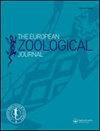Critical thermal maxima of three small-bodied fish species (Cypriniformes) of different origin and protection status
IF 1.6
4区 生物学
Q2 ZOOLOGY
引用次数: 3
Abstract
Abstract Environmental changes related to global warming are both a threat to cold-water fishes and simultaneously create favourable conditions for the spread of eurythermic or warm-water species. In both cases, it is necessary to develop conservation strategies supported by precise ecological data, including thermal requirements. In this study, we determined the upper thermal tolerance thresholds and the critical maxima for three small, non-commercial Eurasian freshwater fish species; i.e. lake minnow Eupallasella (=Rhynchocypris) percnurus, sunbleak Leucaspius delineatus and topmouth gudgeon Pseudorasbora parva using the Critical Thermal Method at different acclimation temperatures, i.e. 18, 23, 28, and 33°C (highest treatment for topmouth gudgeon only). We hypothesized that lake minnow would have the lowest thermal tolerance and the topmouth gudgeon the highest. The response to temperature rise and the upper thermal limits were species-specific and correlated with the acclimation temperature, but not with fish length. Sunbleak showed the lowest thermal tolerance, though at 28°C both E. percnurus and L. delineatus reached a similar critical thermal limit. Topmouth gudgeon showed distinctly higher upper thresholds of thermal tolerance and at the highest acclimation temperature the critical upper limit for the species was close to 42°C. The results obtained for L. delineatus were surprising as we predicted that this leuciscid fish would be more tolerant of high temperatures than E. percnurus. We discuss the results in relation to the threat of extinction and the risk of species spreading beyond their natural range in the context of a warming environment.三种不同来源和保护状态的小型鱼类(鲤鱼形目)的临界热最大值
与全球变暖相关的环境变化既对冷水鱼类构成威胁,同时也为全温或暖水物种的传播创造了有利条件。在这两种情况下,有必要制定由精确的生态数据支持的保护策略,包括热需求。在这项研究中,我们确定了三种小型非商业欧亚淡水鱼的上热耐受阈值和临界最大值;在不同驯化温度(即18、23、28和33℃)下(仅对上嘴鲟进行最高处理),采用临界热法对湖鲦鱼(=Rhynchocypris)、太阳黑鱼(Leucaspius)和上嘴鲟(Pseudorasbora parva)进行驯化。我们假设湖鲦鱼的耐热性最低,而上嘴鲟的耐热性最高。对温度升高和温度上限的响应具有物种特异性,与驯化温度相关,而与鱼长无关。日阴草的耐热性最低,但在28℃时,日阴草和日阴草均达到相似的临界热极限。顶嘴鲟表现出明显较高的热耐受上限,在最高驯化温度下,临界上限接近42°C。结果令人惊讶,因为我们预测这种leuciscid鱼比E. pernurus更耐高温。在气候变暖的背景下,我们讨论了与灭绝威胁和物种超越其自然范围的风险有关的结果。
本文章由计算机程序翻译,如有差异,请以英文原文为准。
求助全文
约1分钟内获得全文
求助全文
来源期刊

European Zoological Journal
Agricultural and Biological Sciences-Animal Science and Zoology
CiteScore
3.10
自引率
5.60%
发文量
80
审稿时长
30 weeks
期刊介绍:
The European Zoological Journal (previously Italian Journal of Zoology) is an open access journal devoted to the study of all aspects of basic, comparative and applied protozoan and animal biology at molecular, cellular, tissue, organ, organismal, population, and community-ecosystem level. Papers covering multiple levels of organization and integrative approaches to study animal form, function, development, ecology, evolution and systematics are welcome. First established in 1930 under the name of Il Bollettino di Zoologia, the journal now has an international focus, reflected through its global editorial board, and wide author and readership.
 求助内容:
求助内容: 应助结果提醒方式:
应助结果提醒方式:


